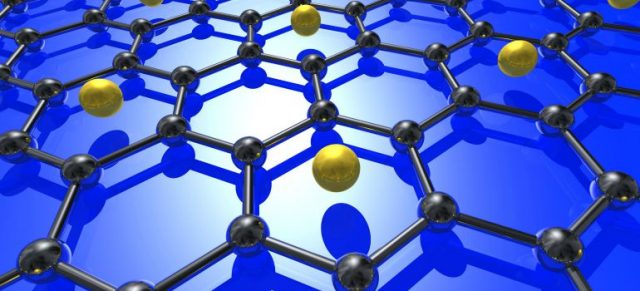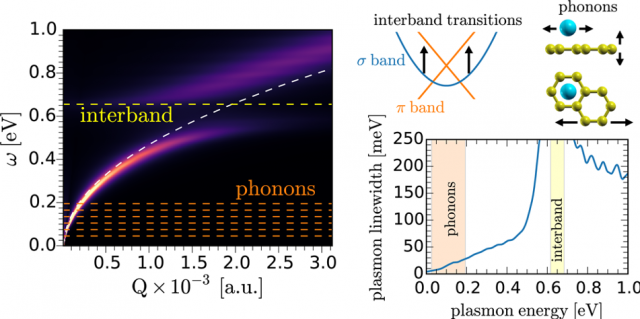How dopants induce plasmon decay in graphene

For centuries, metals were employed in optical applications only as mirrors and gratings. New vistas opened up in the late 1970s and early 1980s with the discovery of surface-enhanced Raman scattering and the use of surface plasmon (collective electronic oscillations at the surface of metals) resonances for sensing. However, it was not until the 1990s, with the appearance of accurate and reliable nanofabrication techniques, that plasmonics blossomed.
Initially, the attention focused on the exploitation of surface plasmons for sensing, subwavelength waveguiding and extraordinary optical transmission. Since then, the scientific and technological interest in surface plasmons has expanded. Recently, surface plasmons have gained renewed attention as the potential mechanism for the confinement of electromagnetic energy, which could reduce the size of optical devices to the desired nanoscale.
The advent of graphene has inspired research into two-dimensional (2D) materials defined by their atomic thickness, some of which are very promising for applications in both the terahertz and mid-infrared regimes. Angle-resolved photoemission (ARPES) studies show that chemical doping by deposition of alkali and alkaline earth metal atoms on graphene introduces much higher concentrations of conducting electrons than the standard electrostatic gating techniques. In fact, theoretical studies point out that lithium-doped single- and few-layer graphene can support plasmons ranging from near-infrared to possibly visible energies due to a high level of doping. This opens new possibilities to extend the application of graphene plasmonics to telecommunication technologies, photodetectors, or photovoltaic systems. Moreover, the 2D plasmon of graphene is a most promising framework to investigate the confinement effects, as a result of its relatively long lifetime and its tunability through electrostatic gating or chemical doping.
But the problem is that the underlying physics of dopant-induced plasmon decay in graphene, that is, how dopants affect the electron scattering processes, is not understood yet. ARPES studies have shown a large increase in the electron−phonon interaction of graphene when alkali and alkaline earth metal atoms are present and that the magnitude of the increase depends strongly on the dopant species. As one of the consequences, the highly doped graphene is believed to be a promising material for achieving phonon-mediated superconductivity in 2D systems. However, the needed decisive quantitative analyses of the 2D plasmon and its decay rate are still lacking in this case.

DIPC’s Dino Novko has investigated the phonon-induced plasmon decay in single-layer and bilayer graphene doped with various alkali and alkaline earth metal atoms (Li, Ca, Sr, K, Cs, and Ba) using ab initio based methods. He reports 1 in Nano Letters that the presence of these atoms alters significantly the electron−phonon coupling strength of intrinsic optical phonon in graphene and that this presence introduces new phonon modes that allow plasmon decay even further. In accordance with the experiments, the calculations show that Li, Ca, and Sr produce the largest electron−phonon coupling strengths, while K, Cs, and Ba produce the smallest.
Novko finds, in addition to the well-known damping channel that comes from the intrinsic in-plane optical phonons of graphene, two new dopant-associated channels: loss due to low-energy phonon modes (out-of-plane graphene motion and in-plane dopant motion), and loss due to interband excitations between graphene and dopant states. Interestingly, the latter excitation strongly interacts with the 2D plasmon, and together they form a new hybrid mode. All of these features depend considerably on the dopant species and the number of graphene layers, which opens new possibilities for tuning the 2D plasmons in graphene.
These findings may aid future design of graphene-based plasmonic devices in selecting the optimal operation energy range and chemical dopants. Additionally, the developed methodology is quite general and can be used for quantitative analysis of phonon-induced plasmon losses in other doped two-dimensional materials.
Author: César Tomé López is a science writer and the editor of Mapping Ignorance.
References
- Dino Novko (2017) Dopant-Induced Plasmon Decay in Graphene Nano Letters doi: 10.1021/acs.nanolett.7b03553 ↩